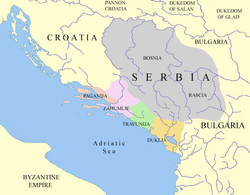Catepanate of Ras
| κατεπανίκιον Σερβλίας Рашка Rascia | |||||
| Principality of Serbia (610-969) Catepanate of Serbia (fl. 969-976) Theme of Sirmium (1018-1043) Principality of Serbia (Duklja) (1043-1101) Grand Principality of Serbia (1101-1217) Byzantine Empire (960-1043) Administrative Unit of Serbia and Byzantine Empire | |||||
| |||||
 | |||||
| Capital | Stari Ras | ||||
| Government | Catepanate | ||||
| Historical era | Middle Ages | ||||
| - | Annexation | 969 | |||
| - | Becomes Theme of Sirmium | 976 | |||
The Catepanate of Ras (Rascia) or Serbia (Greek: κατεπανίκιον Σερβλίας) was a Byzantine province established between 971–976, during the rule of John Tzimiskes (r. 969–976).[1] It comprised the Principality of Serbia; the Ras region; the seat of the Serbian bishopric (Bishopric of Ras) and state (Stari Ras, the capital).
Data on the katepano of Ras during Tzimiskes' reign is missing.[2]
Tzimiskes conquered the area with vigorous resistance.
A seal of a strategos of Ras has been dated to Tzimiskes' reign, making it possible for Tzimiskes' predecessor Nikephoros II Phokas to have enjoyed recognition in Rascia.[3][4] The protospatharios and katepano of Ras was a Byzantine governor named John.[5]
Byzantine military presence ended soon thereafter with the wars with Bulgaria, and was re-established only ca. 1018 with the short-lived Theme of Sirmium, which however did not extend much into Rascia proper.[3]
Notes
- ↑ Dejan, Bulić (2007). "Gradina-Kazanoviće, results of archeological research". Istorijski časopis (55): 45–62.
the establishment of catepanate in Ras between 971 and 976
- ↑ The Byzantine province in change: on the threshold between the 10th and the 11th century. Institute for Byzantine Studies, Serbian Academy of Sciences and Arts. 2008. p. 189.
- ↑ 3.0 3.1 Stephenson, Paul (2003). The Legend of Basil the Bulgar-slayer. Cambridge University Press. p. 42. ISBN 978-0-521-81530-7.
- ↑ Byzantium in the year 1000. BRILL. 2003. p. 122. ISBN 978-90-04-12097-6.
- ↑ Byzantinoslavica. 65–66. Academia. 2007. p. 132.
References
- "The Holy Virgin of Ljeviska, Bogdorica Ljeviska" (PDF). Cultural Corridors of South East Europe.
- Dejan, Bulić (2007). "Gradina-Kazanoviće, results of archeological research". Istorijski časopis (55): 45–62.
- Ćirković, Sima M (2004). The Serbs. John Wiley & Sons. p. 30. ISBN 978-0-631-20471-8.
- Vlasto, A. P. (1970). The entry of the Slavs into Christendom: an introduction to the medieval history of the Slavs. CUP Archive. ISBN 978-0-521-07459-9.